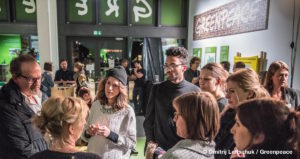Technology continued to accelerate our collective ability to make positive change last year. Citizen uprisings around the world were better networked than ever before and NGOs explored new ways to use digital tools to scale mobilisation efforts. A new wave of grassroots campaign platforms extended the boundaries of the digital organizing toolbox well beyond petitioning by opening enormous citizen networks up to people-led initiatives and bringing cost-effective yet sophisticated and well-rounded campaign tools to both individuals and organizations.
Stories of 2013
Jump down to see lists of some of our favorite 2013 stories.
MoveOn, CREDO Action, ControlShift, and the Action Network are just a few of the organizations and social enterprises enabling and facilitating self-organized campaigning. The range of players entering the world of distributed and open campaigning is contributing to rapid changes in the nature of campaigning that are shifting staffing and structures, helping groups rethink how they support activists and volunteers, changing how campaigns listen and communicate, and further blurring the lines between online and offline organizing.
Check out 4 Things to Watch for with ActionNetwork.org, the New Online Organizing Platform in TechPresident for more about how this and similar platforms are altering the nature of campaigns.
2013 was also a year when citizen journalism, digital organizing and social media propelled broad national protests like those in Brazil and Turkey. Digital campaigning and online networks are not the cause of these uprisings but they’re connecting people more rapidly to one other in responding to political and socio-economic events, keeping them informed and, as Zeynep Tufekci notes, creating conditions for sustainable political and social movements arising from protests.
National protests erupted in Ukraine in late-November when citizens voiced anger at the government’s decision to suspend an association agreement with the European Union. Writing in Global Voices, Tetyana Bohdanova, described how social media was used to turn the Euromaidan protests into a movement.
As the Euromaidan protests in Ukraine entered their second month in late December more stories about the government’s brutal response to demonstrations surfaced and social networks were put to use not only organizing actions but to crowdsource identification of police involved in beating activists and journalists.

A screenshot of a Facebook page for a group of volunteer doctors offering free medical aid for Euromaidan in Kyiv. (Photo via Global Voices)
Last year was also significant for the number and size of on-the-ground mobilisations and actions that advocacy groups organized and scaled with digital tools and tactics. What follows are some of the campaigns highlighted by members of the MobLab community.
Our friend Chris Eaton suggested that “2013 was a game changer for online to offline mobilization in the United States. We saw it first with the wave of Change WalMart protests across the country that mixed online organizing and coaching to propel dozens to stage sit-ins this November.
And with dozens of trainings across the country and a sophisticated network of volunteer action leaders and coaches, The NoKXL Pledge of Resistance laid the ground work to mobilize 76,000 people to take action in opposition to the Keystone XL tar sands pipeline.
Both…have amazing parallels even though they were organized by very different issue areas.”
Matt Price also felt that digital organizing in support of direct mobilization played a big role in 2013 campaigns. Matt pointed to the “great organizing on tankers and pipelines in British Columbia with First Nations playing a real leadership role. Kudos to groups like Leadnow.ca, Dogwood Initiative and Forest Ethics Advocacy for mobilizing thousands of people in a distributed way.”
Canada-based Idle No More sought justice for First Nations communities facing environmental destruction from tar sands development. The campaign deftly wove digital organizing and on the ground actions to create, as TruthOut.org put it, a powerful international campaign against transnational corporations with indigenous communities and concerns at its core.
2013 also brought us lively debates over the power of social media to contribute to social change as Evgeny Morozov and Steven Johnson went head-to-head in New Republic. Morozov kicked off the exchange with his essay Why Social Movements Should Ignore Social Media which served as a withering critique of Johnson’s book Future Perfect: The Case for Progress in a Networked Age. It’s arguable that Johnson and Morozov each went after the extremes in the other’s arguments. Memes aren’t the answer to our social ills but campaigners ignore networks (digital, social, human or however one labels them) at their own peril.
Trends to Watch in 2014
We wanted to highlight a few of the trends of 2013 that we think are worth tracking into the next year or two… (add your ideas about what’s coming in the comments):
GRASSROOTS-LED CAMPAIGNS
Open online platforms are giving people more opportunities to create not just one-off petitions but also full-blown strategic campaigns that bring together communications, data, leadership development, organizing principles and even fundraising tools needed to grow and sustain protracted efforts.
The growth in platforms that enable people-powered campaigning brings new questions: How do these “people-led campaigns” platform actually work? What kind of impact are they actually having on the world? What are the wider implications of this new approach to campaigning for individuals and organizations? Should every group launch their own people-led campaigns platform? If not, why not?
We tackled these and other big questions from 2013 in a new Mobilisation Lab report — Grassroots-led Campaigns: Lessons from the new frontier of people-powered campaigns — which summarizes the wisdom and insight of the people at the cutting edge of people-led campaigning platforms and programs.
For organizations able to invest in supporting individuals in developing campaigns, this open approach can help organizations achieve their missions, build lists, and develop leaders. Look for more organizations to encourage people-led campaigning efforts in the coming year. We’re especially interested in how organizations support these projects and the external people participating.
PERSUASION
Today, innovators at campaigns, socially-oriented startups and many organizations are combining data, social media, email, online monitoring tools, a dash of a journalistic storytelling and emotion to reach more people in deeper, more powerful ways. They’re going for the empathetic nodes that have the power to change behavior and opinions. It’s a bit of a rethinking of campaigns and communications that may further impact how we plan and staff digital mobilisation.
Two talks at Personal Democracy Forum by Upworthy’s Sara Critchfield and Upwell’s Rachel Weidinger reminded us how good we are at preaching to our choirs but how much further we can still go to reach new audiences. David Karpf elaborates in A Web of Persuasion, or a Web of Mobilization.
Perhaps the genius that delivered by Upwell, Upworthy and others that are synthesizing data, emotion and organizing is their focus on working across boundaries of politics, supporter lists, and personas. Critchfield and Weidinger want to persuade, not just send messages. It’s a path towards greater change that we’re hoping more can follow.
CONNECTION
TechPresident’s Micah Sifry is one of several analysts whose writing has questioned the genuine power that campaign groups and platforms such as MoveOn and Change.org have available (and, yes, we acknowledge these two are very different applications). In February, Sifry examined group collaboration platform Loomio as a vehicle for explaining the value that interactive joint decision making may bring to campaigns and movements. Can Social Software Change the World? Loomio Just Might perhaps overstates the potential of Loomio but does open up a dialog about the importance of real connection to building power building.
J. Nathan Matias of MIT’s Media Lab Center for Civic Media takes the power (and many flavors) of personal connection in social change a bit further in his July post, How to Choose the Best Way to Create Change. Those of us working deeply with campaigns and digital mobilization sometimes gloss over the power of personal connection or presume its presence in an email list. Matias does a great job identifying the many ways technology can help create change, including better support for people and communities.
BIG DATA, BIG LISTENING, SMALL DATA, SMALL LISTENING
Big Data saw a bit of a backlash in 2013 but the underlying concept – grabbing and mashing up larger and more data sets to create better insights – found increased attention from campaigns and organizations seeking ways to run more informative tests, learn more quickly, and better understand the conversations and sentiments around them.
Listening to social media and drawing useful insights from that listening is a substantial challenge to campaigns as they try to connect with and persuade both likely and unlikely supporters. Upwell is one group helping pioneer ways for organizations to learn from and test monitoring, showing how data helps explain what messages are working, and training others.
But do you have to be a HUGE campaign to use big data and big listening? Just how small can you go with these tools is a question that was asked more often as 2013 progressed. Despite some scattered exceptions, most campaigns are still struggling to scale down that Obama magic (Nancy Scola in Next City) when it comes to data. Look for more on how to craft stronger campaigns with data and testing from the Mobilisation Lab and our partners in 2014.
Here are some of our favorite articles from 2013 and some looks at where we’re headed in 2014 and beyond.
Distributed Campaigning
- Q&A with SignOn: Letting the People Lead — Behind MoveOn.org’s massive transition to citizen-led campaigning [Mobilisation Lab]
- MoveOn Bets its Future on Volunteered Ideas [Sarah Lai Stirland, TechPresident]
- When mobilisation takes on a life of its own [Mobilisation Lab]
- 4 Things to Watch for with ActionNetwork.org, the New Online Organizing Platform [David Karpf, TechPresident]
- Unbranded efforts changing the ‘campaign complex’ [Mobilisation Lab]
- Netroots Goes Global [David Karpf, The Nation]
The Intersection of People Powered Mobilisation and Technology
- Everything is Connected: Can Internet Activism Turn into a Real Political Movement? [The Economist]
- Leadership in Horizontal Movements [Charlie Detar, MIT Center for Civic Media]
Networks and Social Media in Social Action around the Globe
- The Secret Behind the Turkish Protesters’ Social Media Mastery [Alex Kantrowitz, PBS MediaShift]
- “Come, Come, Whoever You Are.” As a Pluralist Movement Emerges from Gezi Park in Turkey [Zeynep Tufekci, Technosocial]
- Twitter a Mirror for the Turkish Press, and the Reflection isn’t Pretty [Lisa Goldman, TechPresident WeGov]
- ‘Vinegar Revolt’ Bus Fare Protests Spread Across Brazil [Fernanda Canofre, Global Voices]
- Brazil uprising points to rise of leaderless networks [Debora MacKenzie, New Scientist]
- How Internet Tools Turned Ukraine’s #Euromaidan Protests into a Movement [Tetyana Bohdanova, Global Voices]
- Romanian Autumn – Global mobilisation for Rosia Montana puts pressure on the Romanian Parliament and government. The protests continue! [Salvati Rosia Montana]
MobLab Resources we were proud to share this year
- The Mobilisation Integration Toolkit
- Anatomy of People-Powered Campaigns
- Four Magic Steps to Creating Shareable Purpose-Driven Social Media Content
Highlights from the MobLab blog in 2013
- How to organize without taking the lead
- Want more Facebook activity? Surprise them and make ’em happy
- Half million ask Volkswagen not to give into… the Dark Side (Case Study)
- Six tricks for creating remarkable web campaigns
Top photo: Istanbul protestor (credit: Oren Ziv/Activestills.org via TechPresident)




